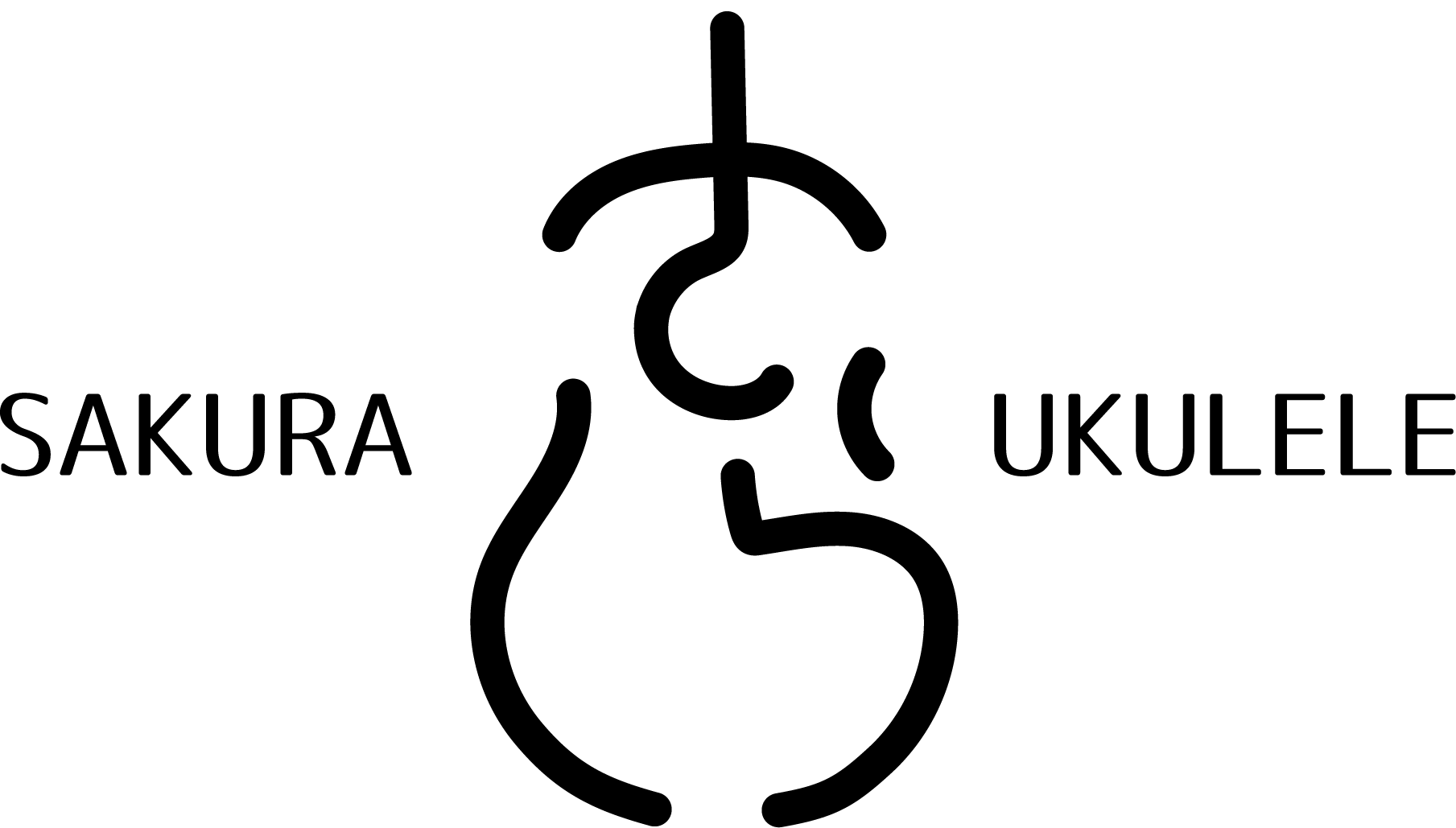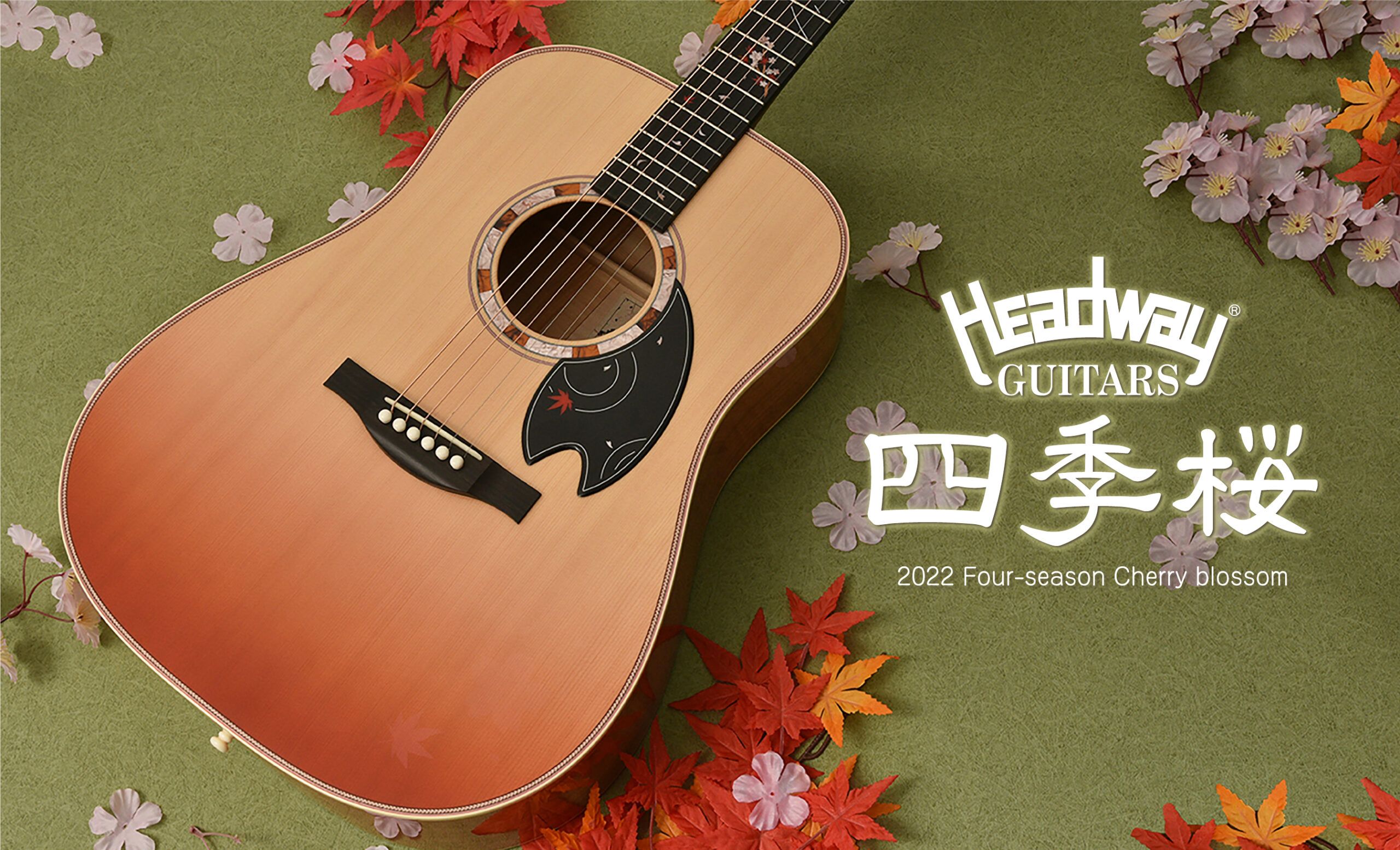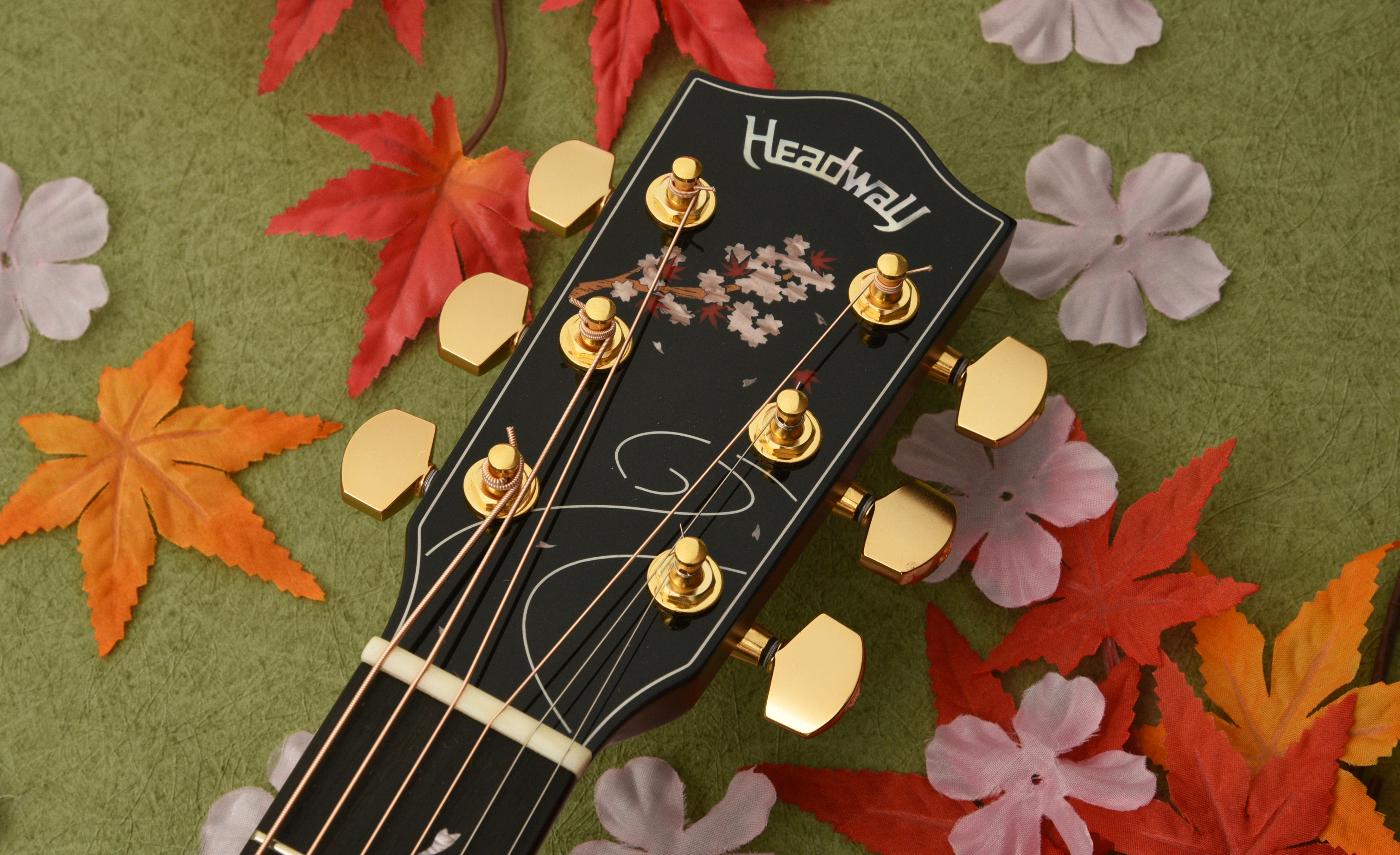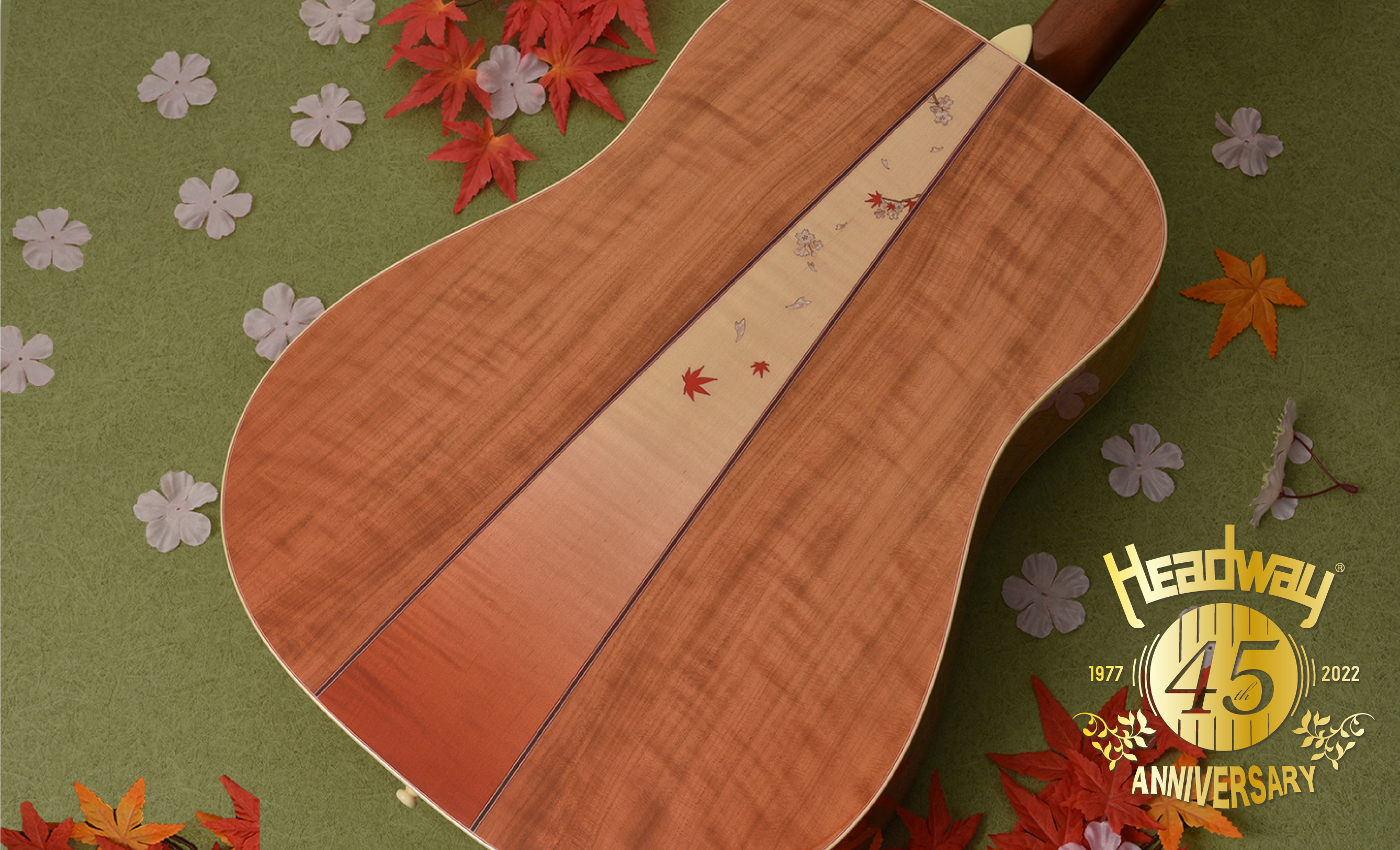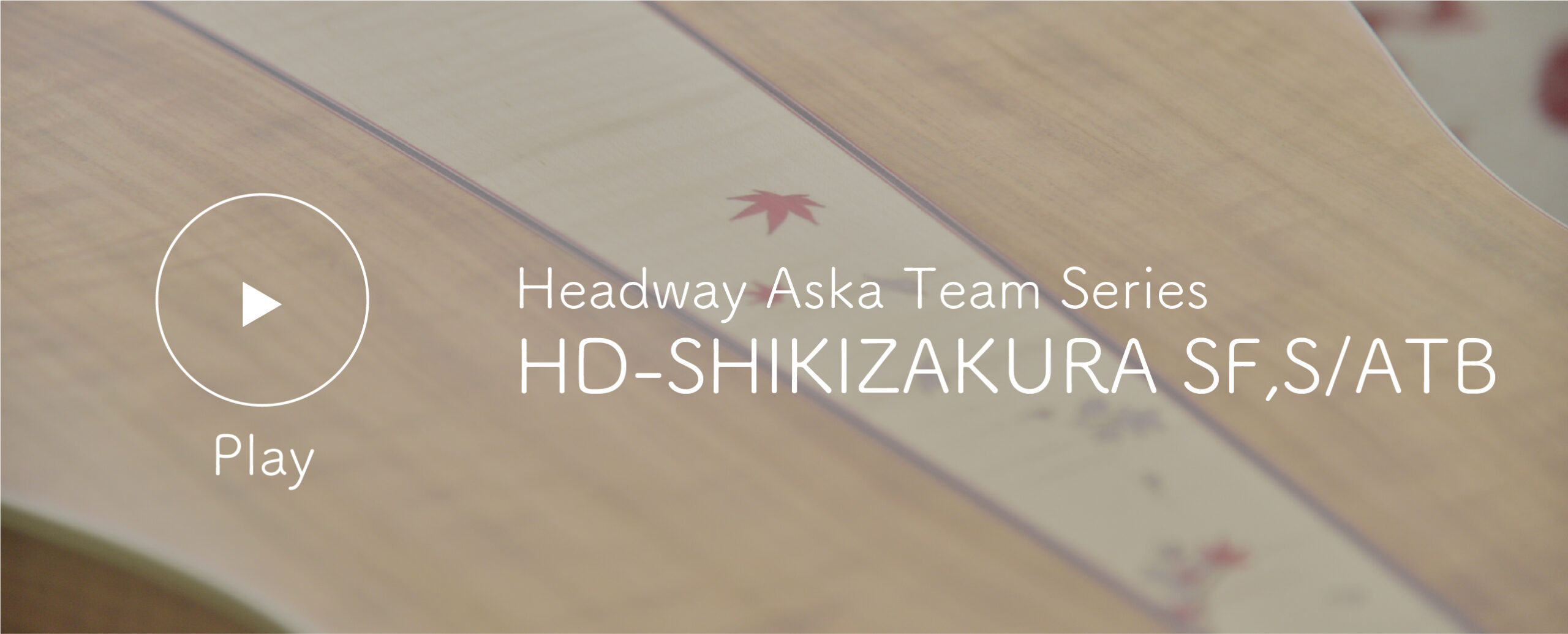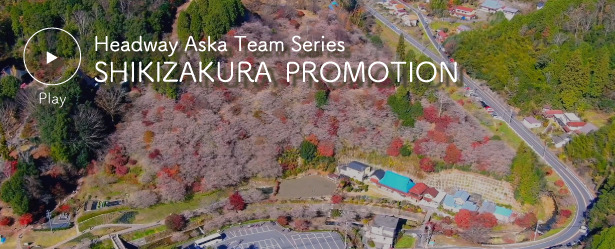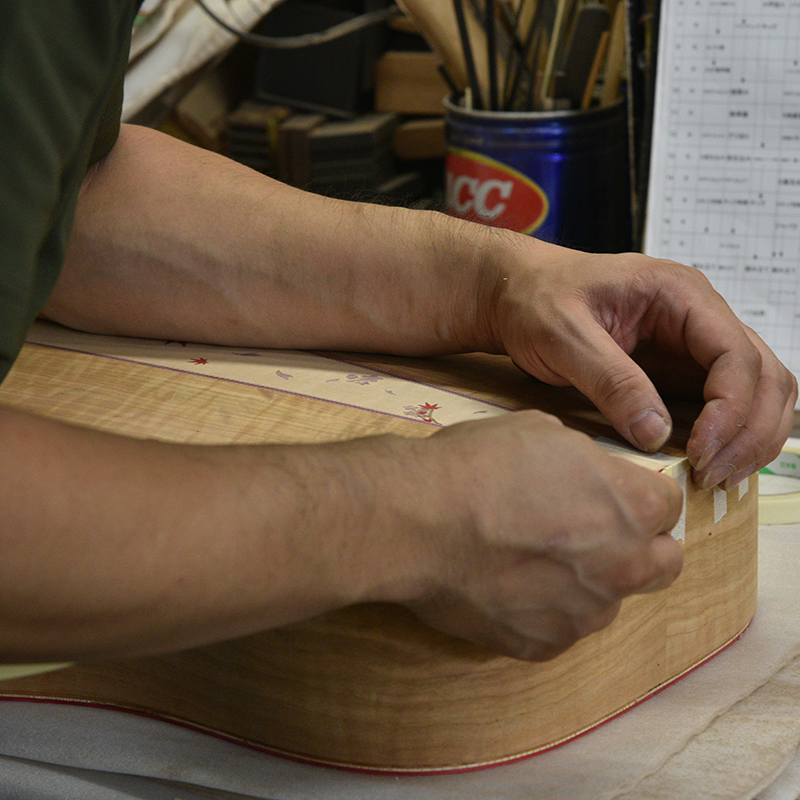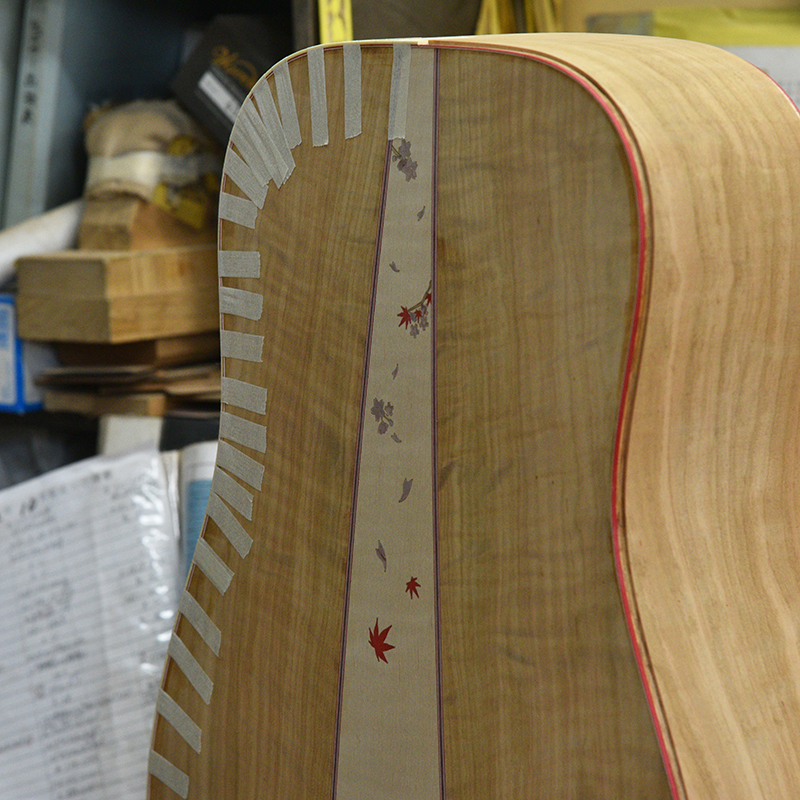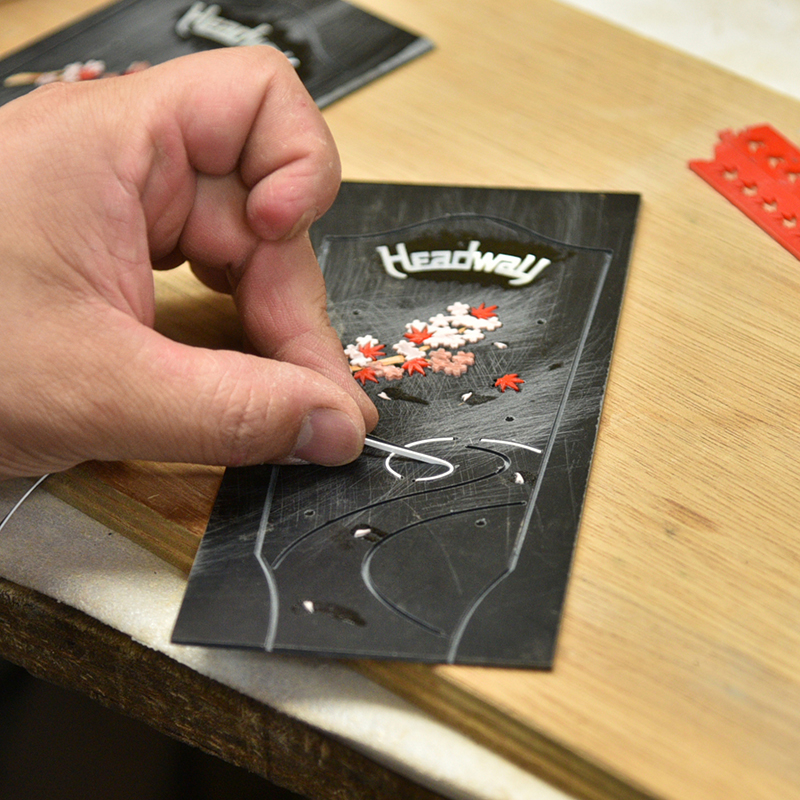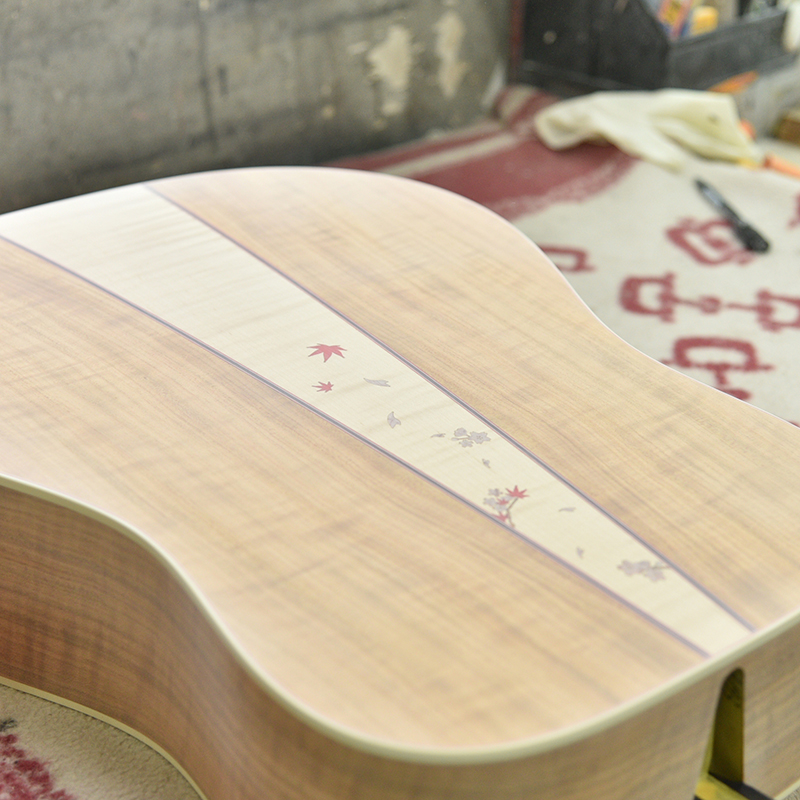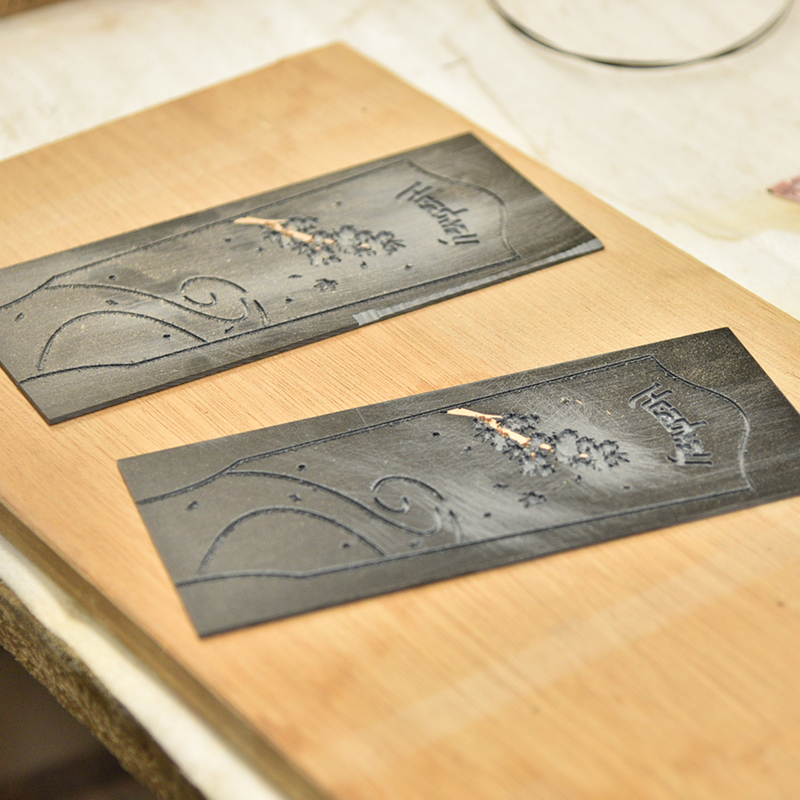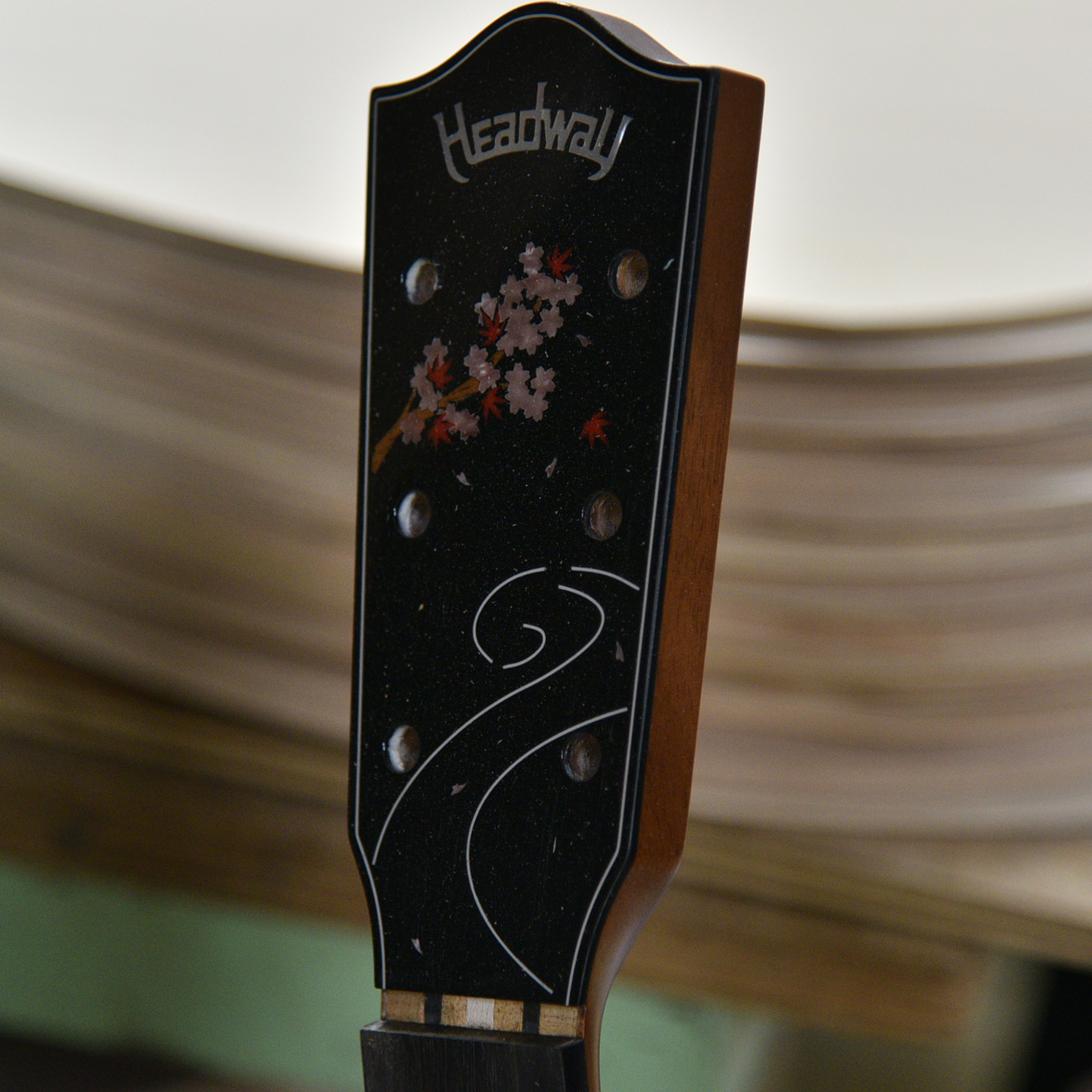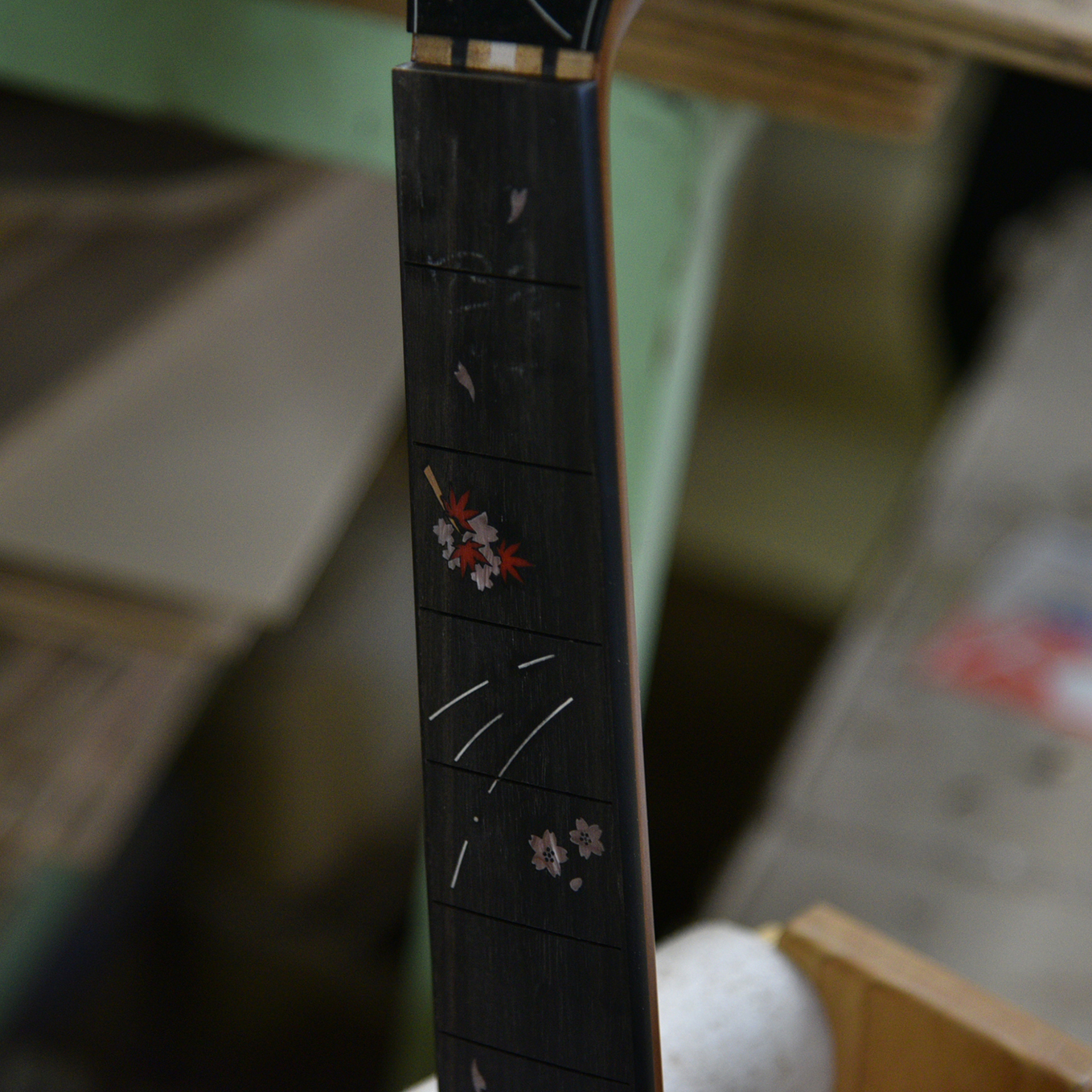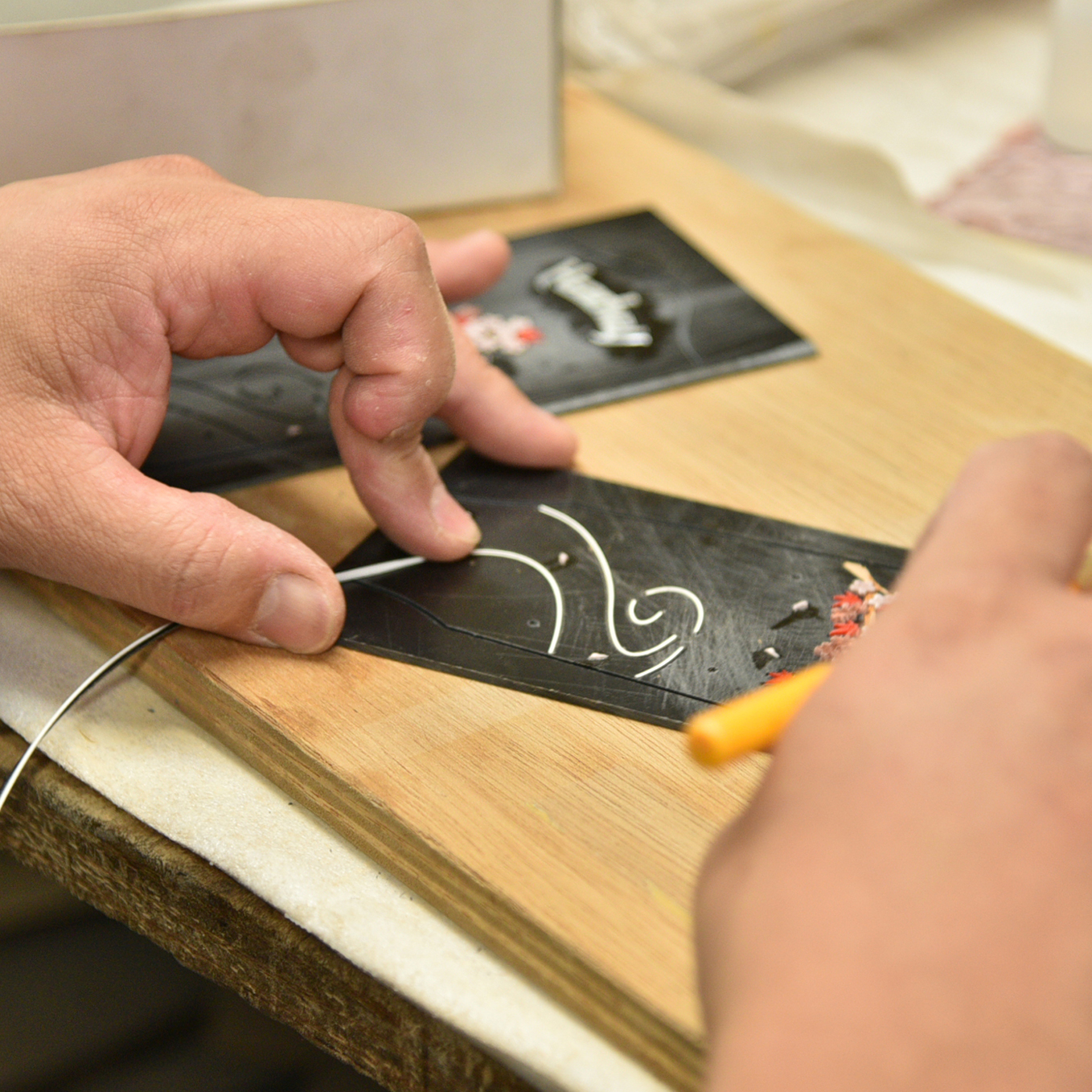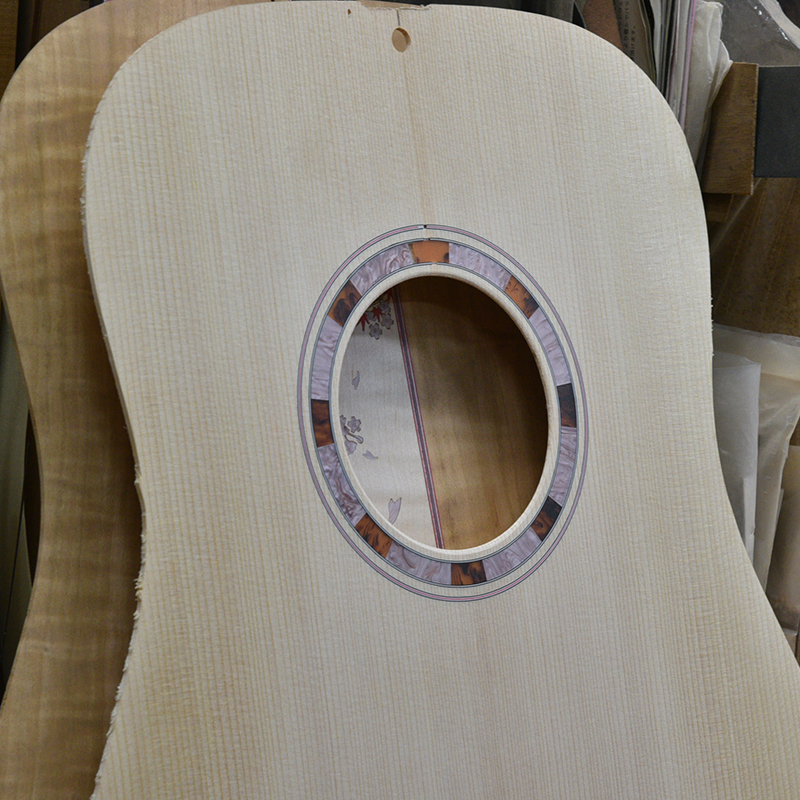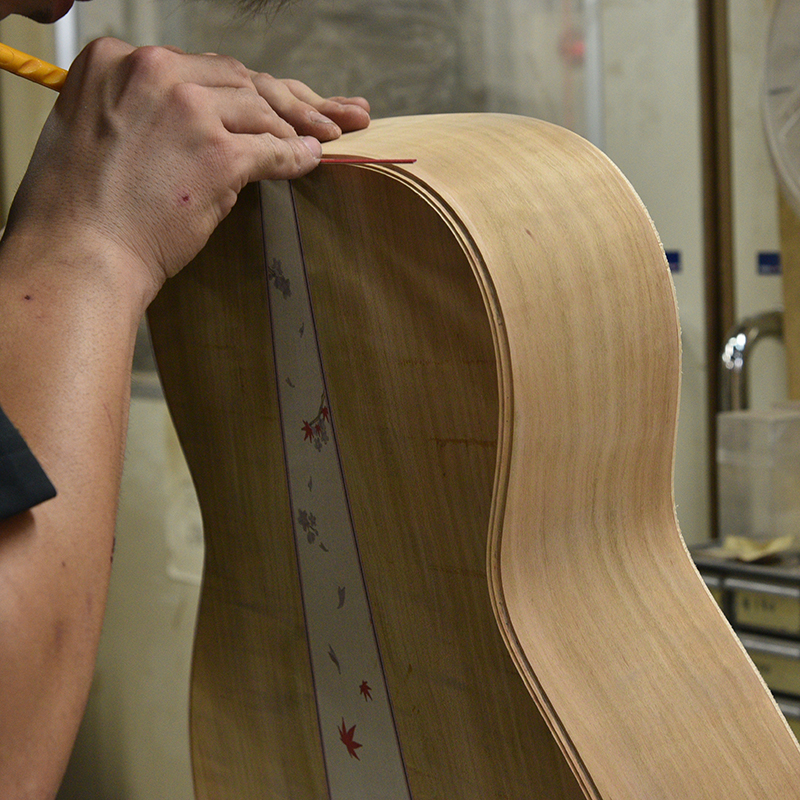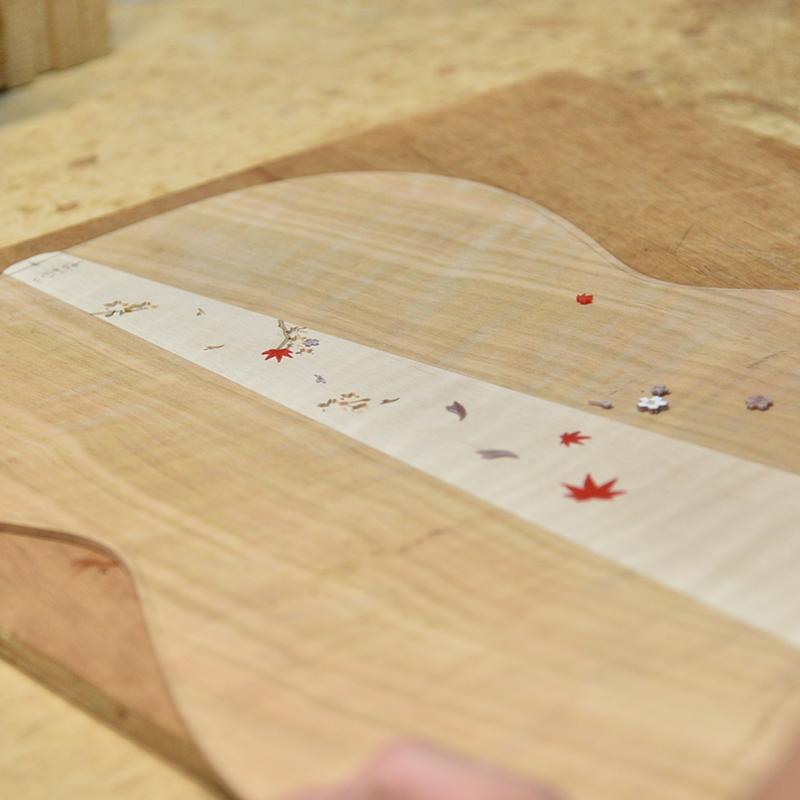With Obara’s four-seasons cherry blossom trees as a motif, we designed this 2022 Autumn-colored Cherry blossom model
This is a limited edition fall model of the popular Headway Sakura guitar Series. While we have produced spring, summer, and winter-themed models, an autumn-themed model has been a long time coming. Last year, in 2021, we heard that there was a cherry tree in Obara, Toyota City, Aichi Prefecture, that blooms from fall to winter. Furthermore, we were told that they coexist with autumn foliage, so we began production of a cherry blossom guitar based on the motif of the four seasons cherry trees in Obara with the approval of the official Tourist Association of Toyota City. This guitar is closely follows the 2021 model deisgn, but with updates throughout, including a 3-piece back and holographic coating. The result is a guitar that allows you to enjoy the charm of Ohara’s seasonal cherry blossoms all year round.
What does Shikizakura mean?
Shiki-zakura is one of the varieties of cherry trees that bloom from fall to winter. Although cherry blossoms are most often associated with spring, there are also many cherry trees that bloom even after the weather turns cold. Cherry blossoms delight us in accordance with the four seasons in Japan. The best thing about Shikizakura is that they can be enjoyed at the same time as autumn leaves. We have chosen Shikizakura as a motif for autumn so that the scenery created by Japan’s four seasons will never wither and will always be close to us. The design of the inlay work is based on materials provided by the Obara Tourist Association of Toyota City.
Production limited to 15 units
Headway HD-SHIKIZAKURA’22 SF,S-ESU/ATB
Headway
HD-SHIKIZAKURA’22 SF,S-ESU/ATB
MSRP・・・¥360,000(w/o taxes)
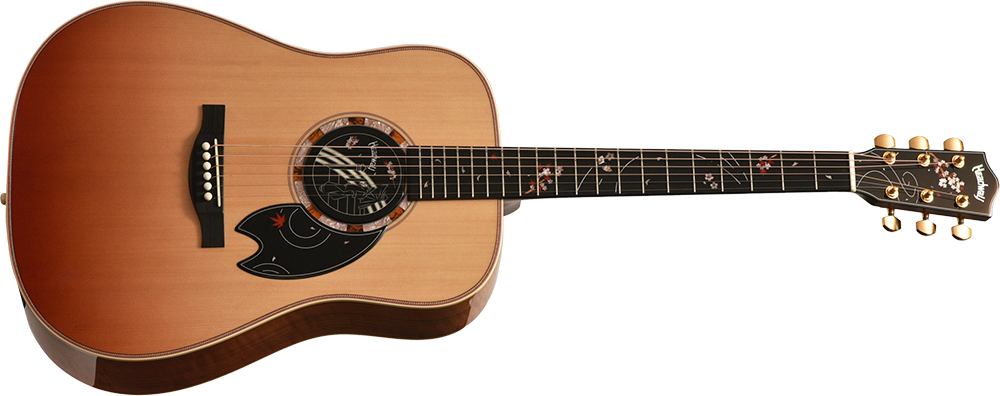
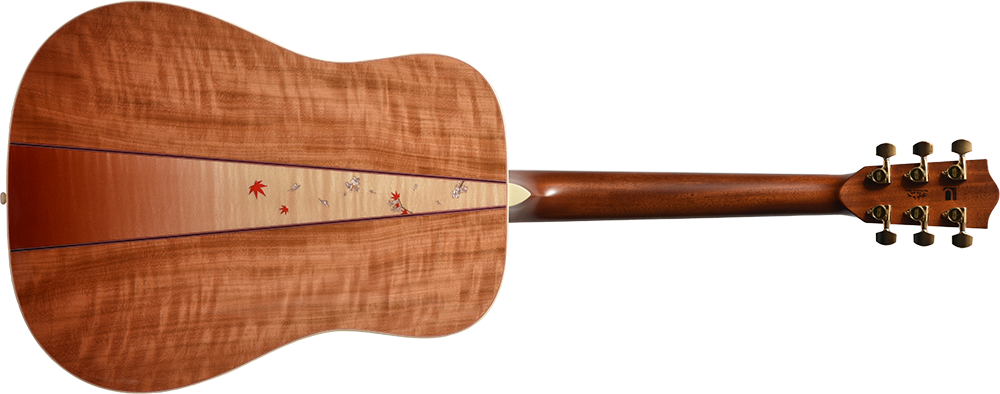
Production limited to 15 units
Headway HF-SHIKIZAKURA’22 SF,S-ESU/ATB
Headway
HF-SHIKIZAKURA’22 SF,S-ESU/ATB
MSRP・・・¥360,000(w/o taxes)
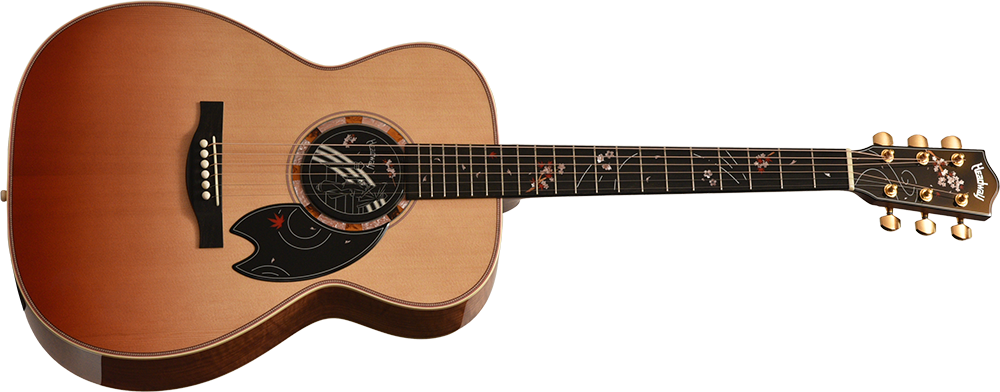
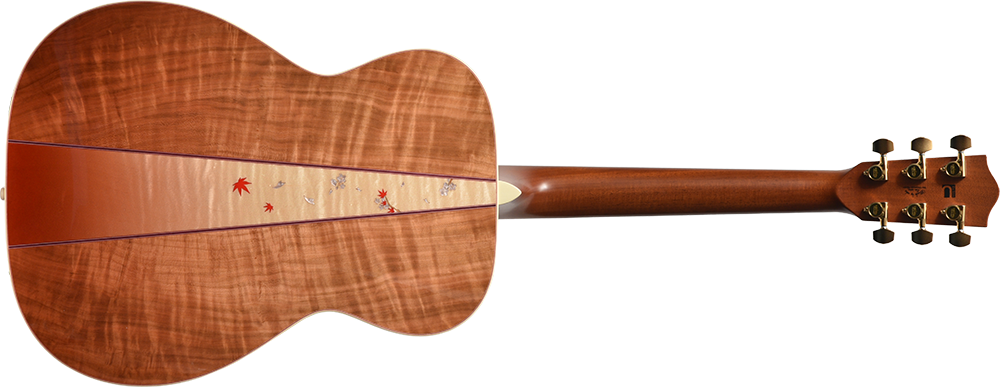

Kawami Shikizakura Inspired headstock inlay
The inlays for this model are inspired in Kawami, a famous location that exists within Obara, since the “Kawa” in its name means river, we figured it was a great fit for our flowing autumn cherry blossom petal design. The detailed parts are hand-inserted by craftsmen, and various materials are used to create a three-dimensional finish.
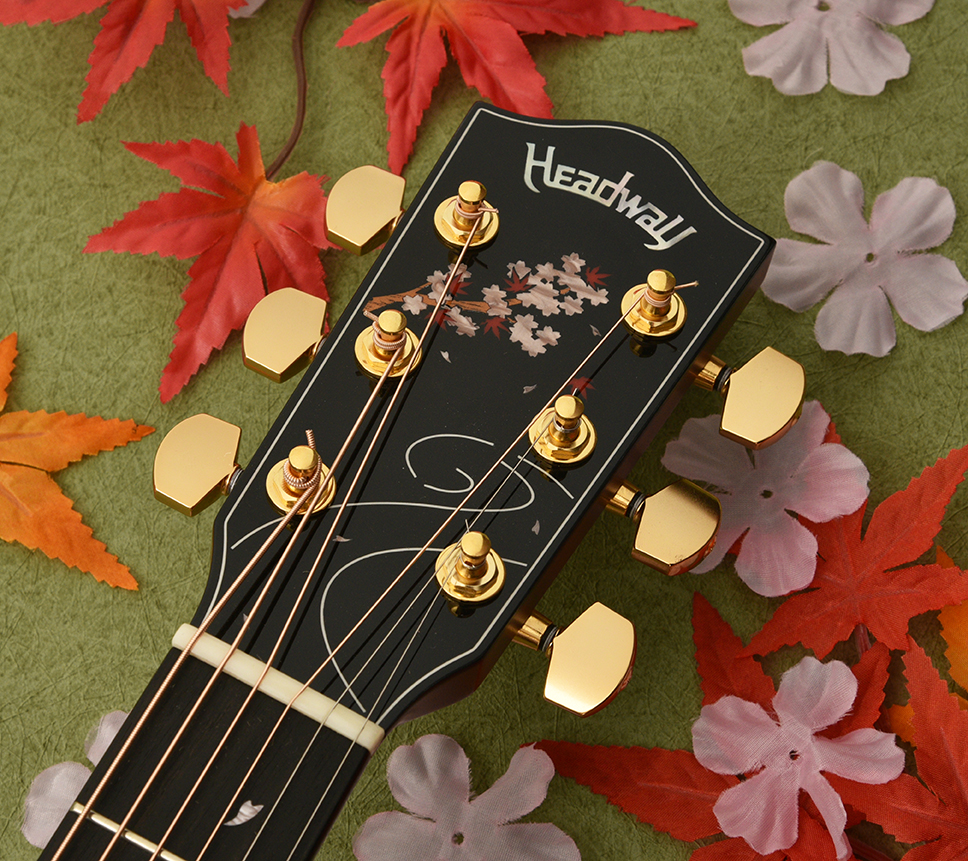
The petals that flow alongside the river
A flowing river design is also included on the jet-black ebony fingerboard. Cherry blossom petals and autumn leaves are placed at the 3rd, 5th, 7th, 9th, and 12th frets, and are flowing with the river from the headstock to the neck end, so that the player can play without losing sight of his position when switching from the regular dot position model.
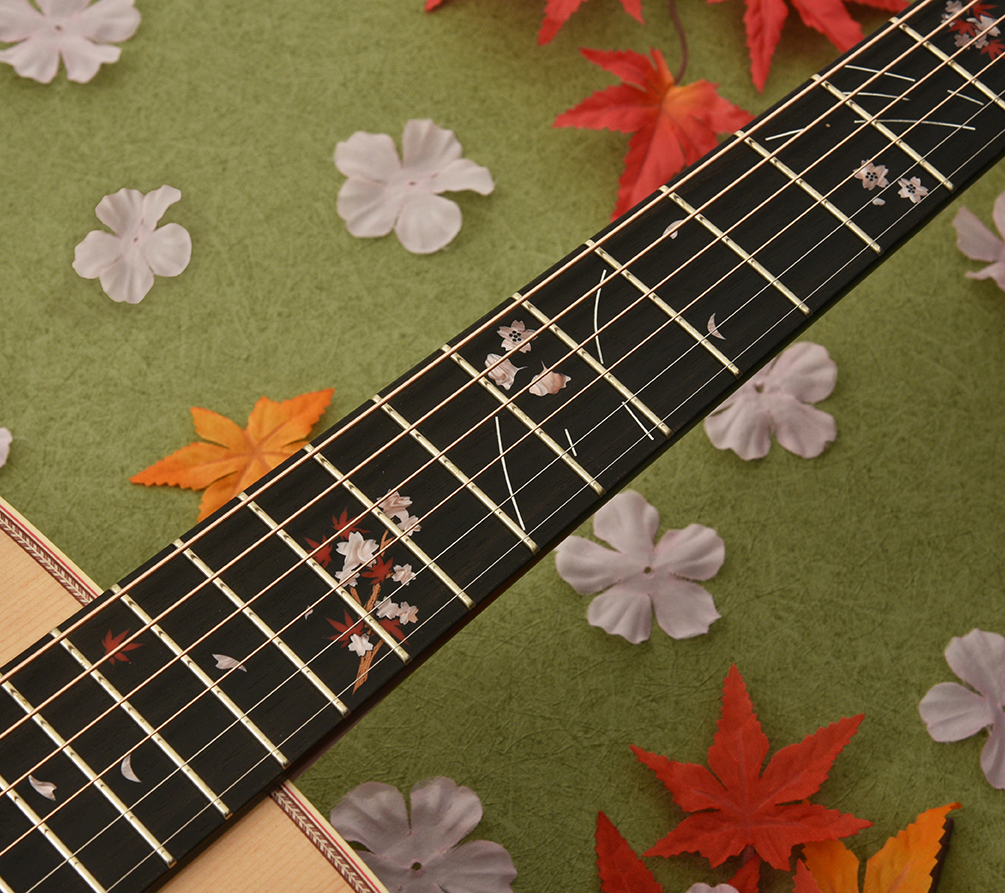
Shikizakura petals gently landing in water
A momentary scene of cherry blossoms and autumn leaves falling on the surface of the water is used in the pickguard design. In addition, two different acrylic materials are used for the rosette around the sound hole to express the coloring produced by the four seasons of cherry blossoms. A sound hole cover is also included, incorporating a design of a woman in kimono, a common theme for the 2022 Sakura model.
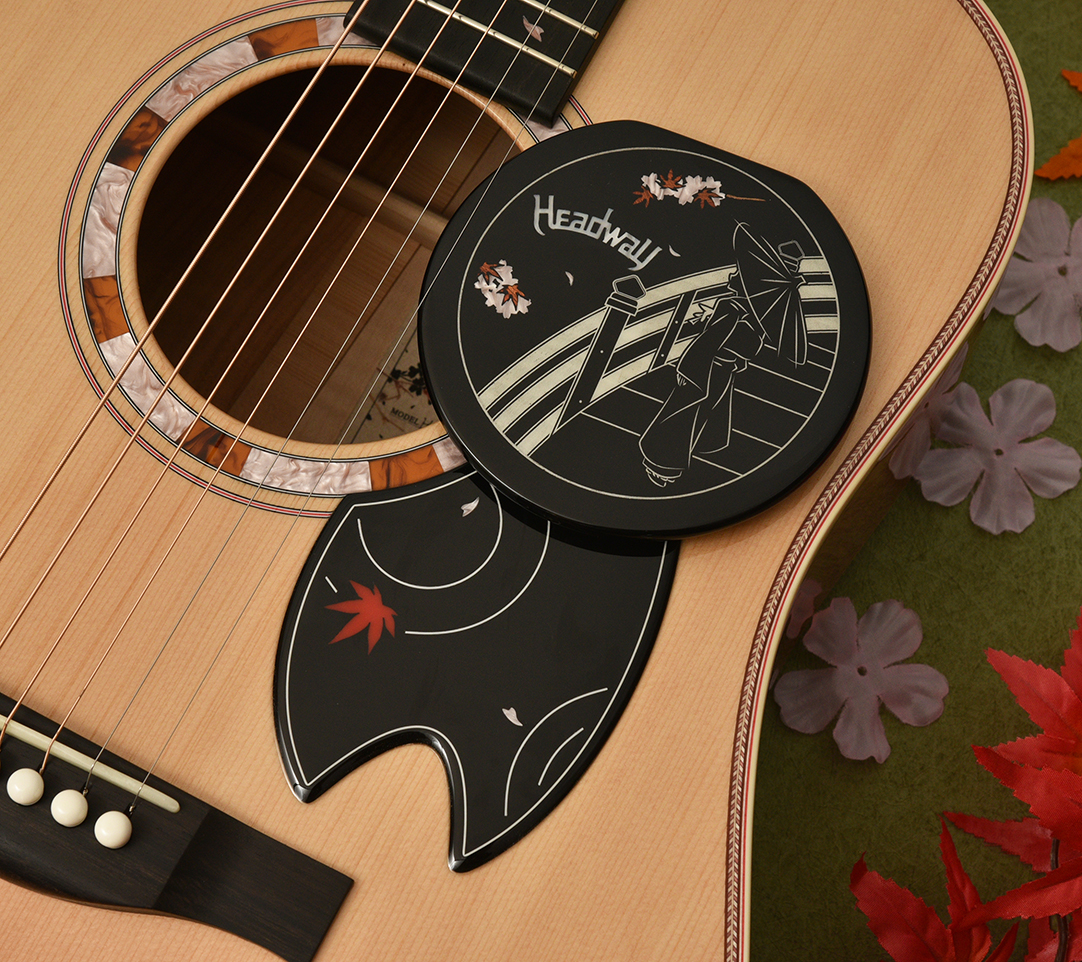
A coloring that lets you feel the autumn
The “Autumn Red Gradation” finish is a colorful autumnal gradation. The gradation expresses the gradual change in hue folliage experinces during autumn. The lower part of the body is coated with a holographic layer that appears depending on the angle and the reflection of light, bringing out the design of cherry blossoms and autumn leaves.
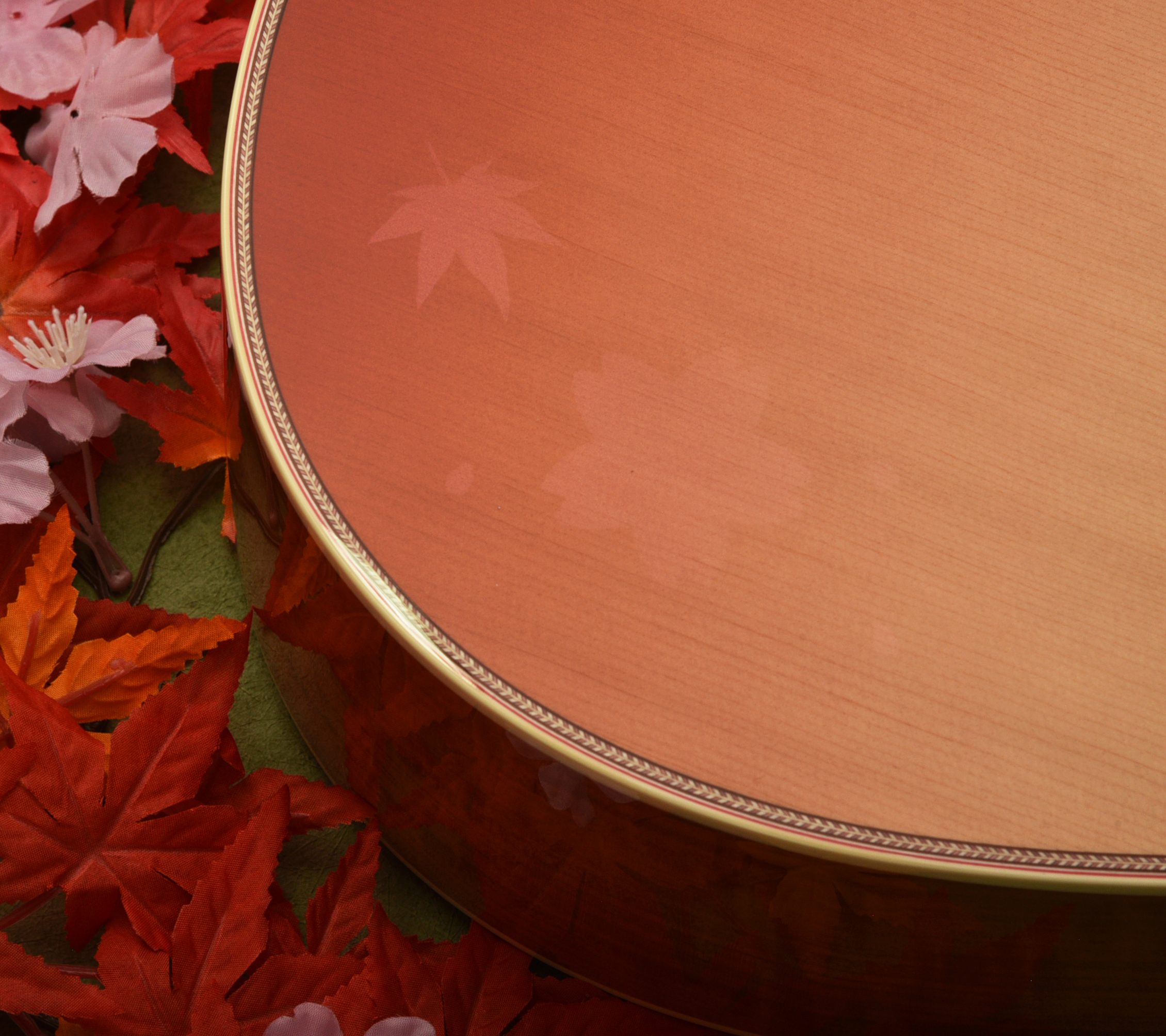
Fluttering autumn folliage and cherry blossoms
The center of the 3-piece back is made of maple wood with elegant inlays of falling cherry blossoms and autumn leaves. The finish gives a sense of the scenery of Obara even when viewed from behind. Furthermore, by painting the gradation in elegant red color, the leaves that have fluttered down are piled up, giving the image of a landscape where the whole surface is dyed in autumn leaves.
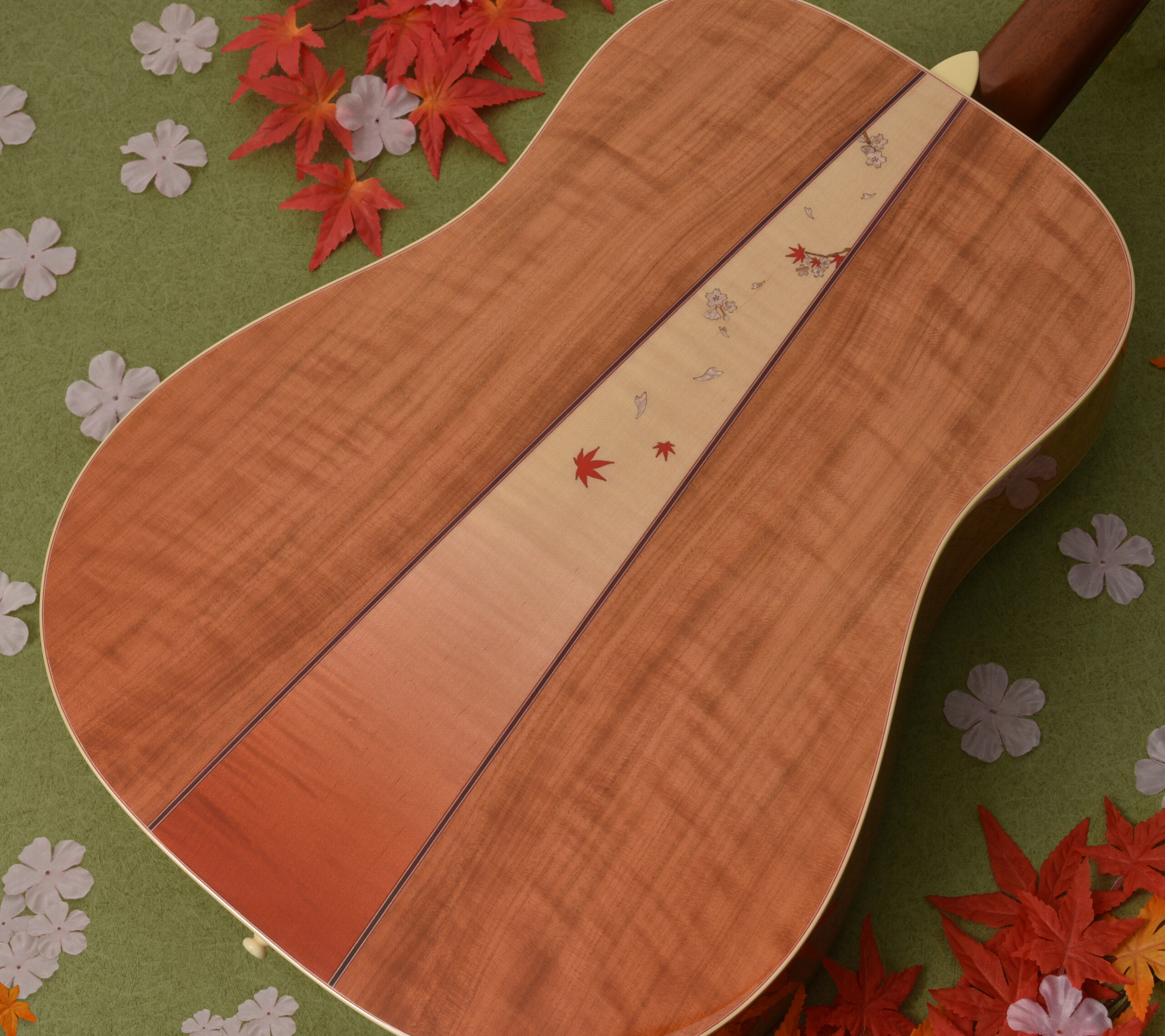

Extra-slim U neck
The extra-slim U-neck is the thinnest in Headway’s history and has a shape that is easy to grip. The neck is reinforced with carbon rods to maintain Headway’s traditional characteristics of durability and stability. This is a trustworthy neck grip that anyone can play comfortably. Both women and players with smaller hands, which can sometimes have problems with some necks, should give it a try. The semi-glossy finish, which resembles a neck that has been used and worn in for a while, provides a good grip that allows the hand stick to the neck when just right. In addition, the carbon port increases rigidity and leads to better response.
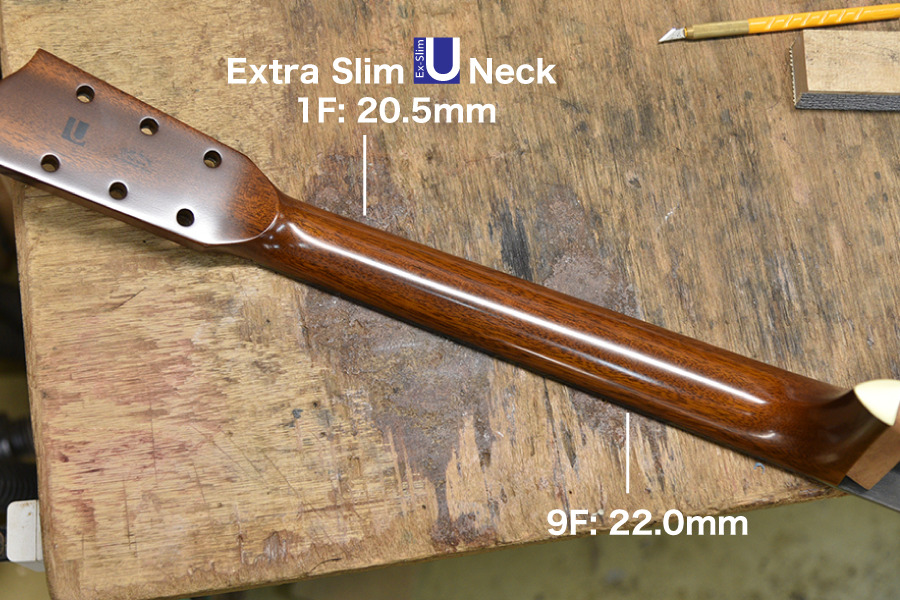
34 Bracing
Headway Master Builder Momose has adopted the “34 bracing” layout, which he has found to give the best on his recent production experience. The layout is closer to a “semi-forward shift” with the X-bracing crossed 4.6mm closer to the bridge side than the forward shift, which is very appealing in terms of strength and stability. The combination of the softness and overtones of the forward-shift bracing and the hard maple wood results in a sound that responds well to even the most delicate and sparkling touch.
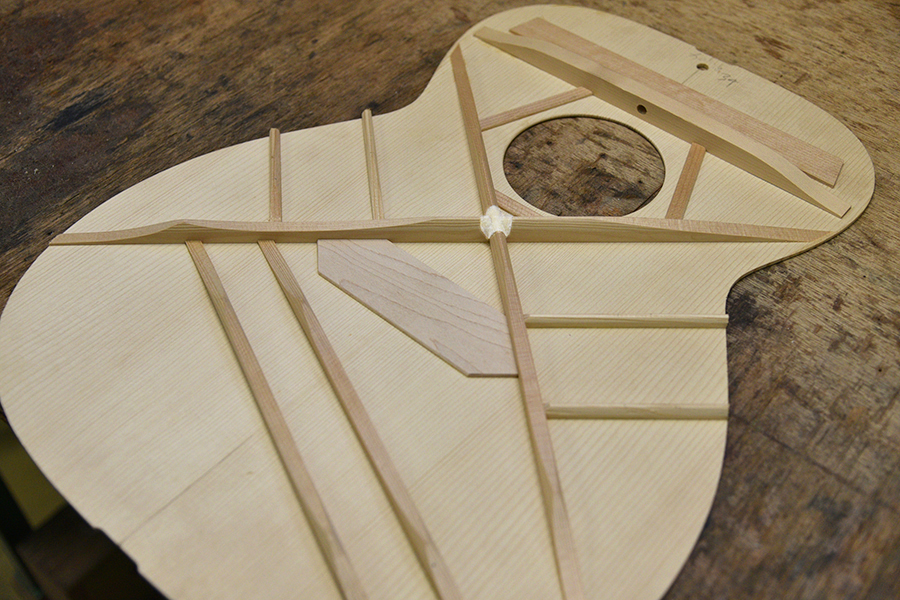
Dovetail Joint
Headway uses the traditional dovetail joint method. While in recent years there have been an increasing number of models with simpler bolted joints, the dovetail joint has a larger joint area, and when finished precisely, the neck and body produce a rich sound as if they were a single piece of wood. The joint’s protrusion, called a “dovetail,” is made larger than a standard joint, and a special jig is used to join them together. Adjustment of the neck angle and other parts at this point greatly affects playability and sound, and is a process that requires a high level of skill to pull-off.
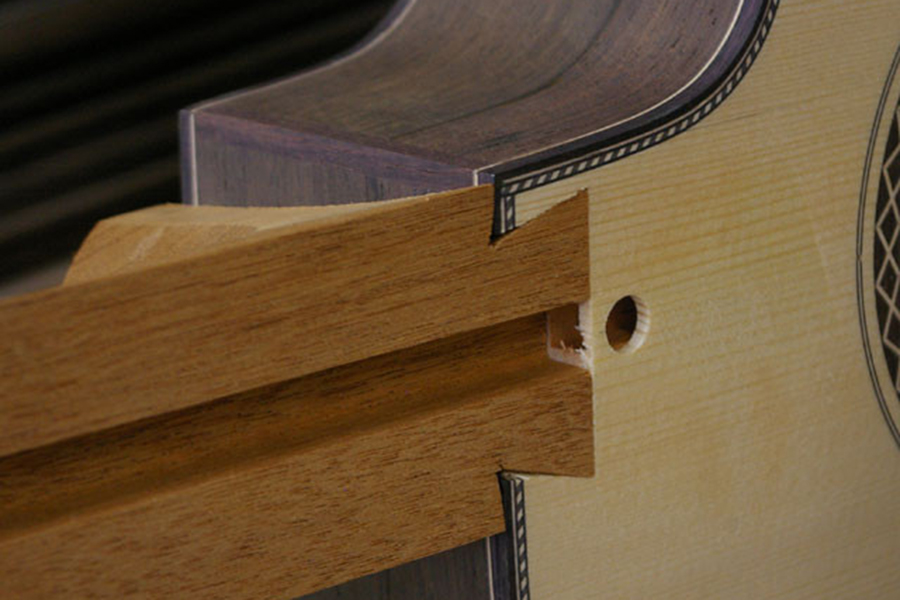
Sakura x Kaede
The body back is made of Yamazakura, a Japanese wood with distinctive flame-grain patterns. The body is constructed with a 3-piece construction, and kaede (Japanese maple), is used for the center wood. Both materials, yamazakura and kaede, are relatively hard and solid, and the slightly sweet sound characteristic of yamazakura is combined with the crisp and clear sound of kaede, resulting in a sweet and fresh sound that can be produced even by a light touch.
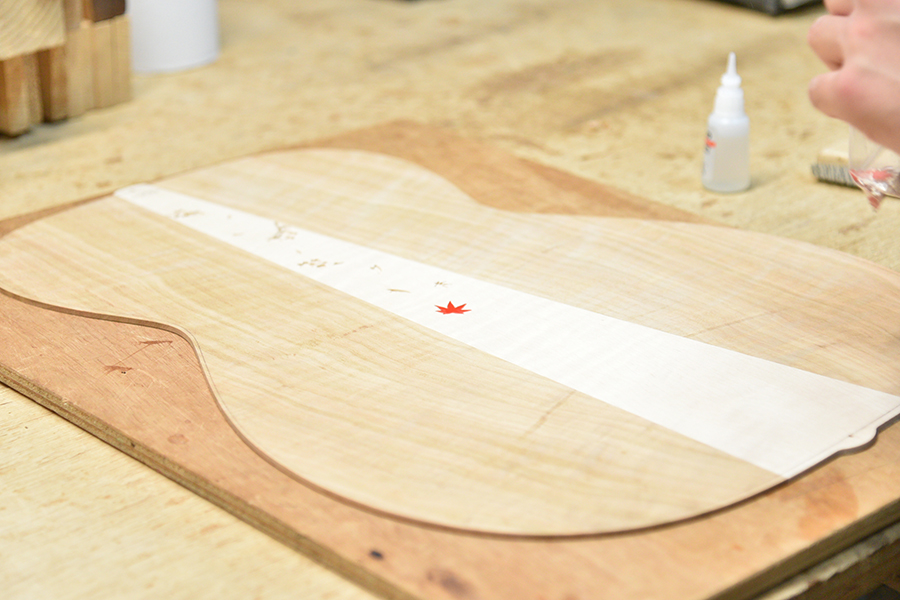

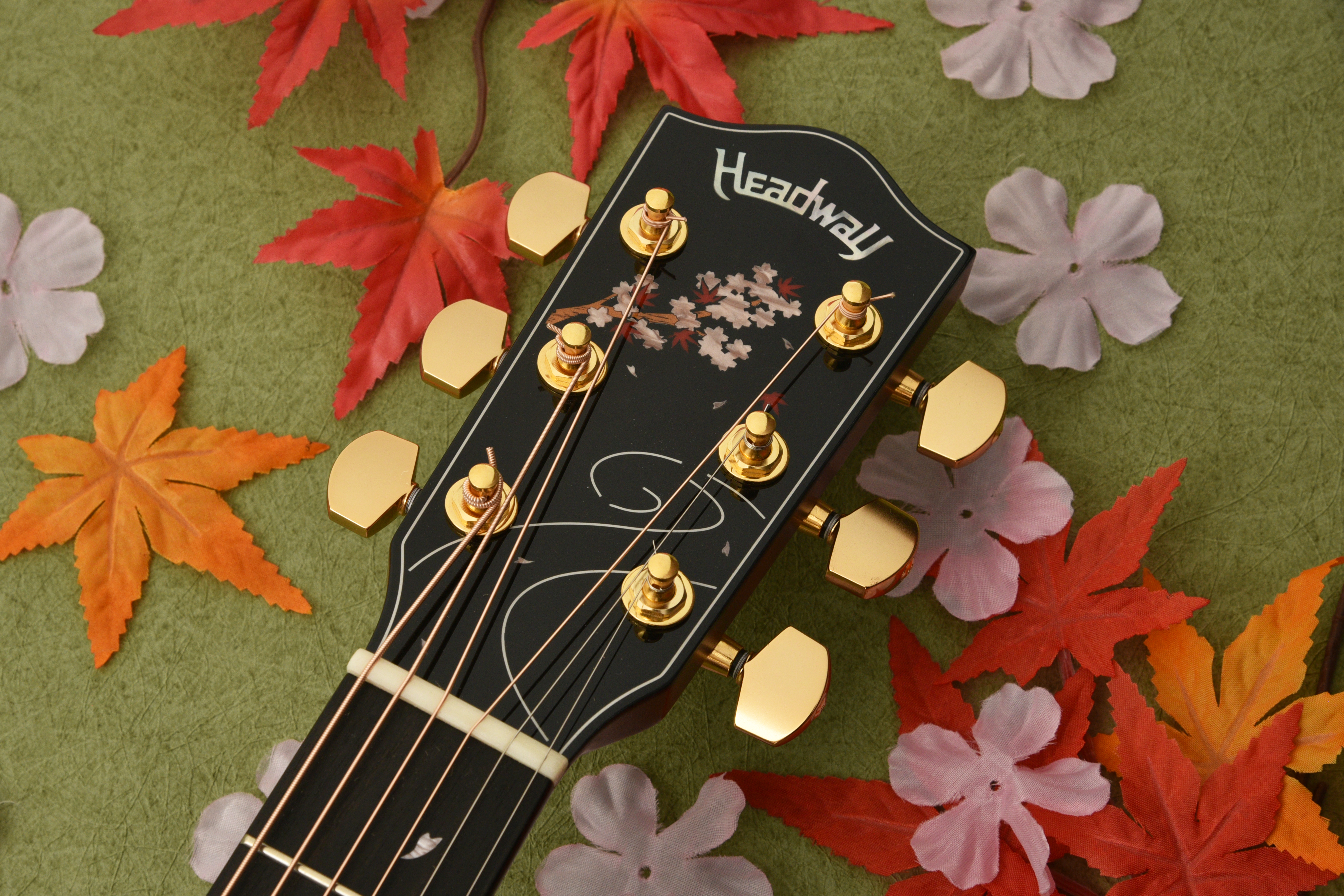
The inlays for this model are inspired in Kawami, a famous location that exists withing Obara, since the “Kawa” in its name means river, we figured it was a great fit for our flowing autumn cherry blossom petal design. The detailed parts are hand-inserted by craftsmen, and various materials are used to create a three-dimensional finish.
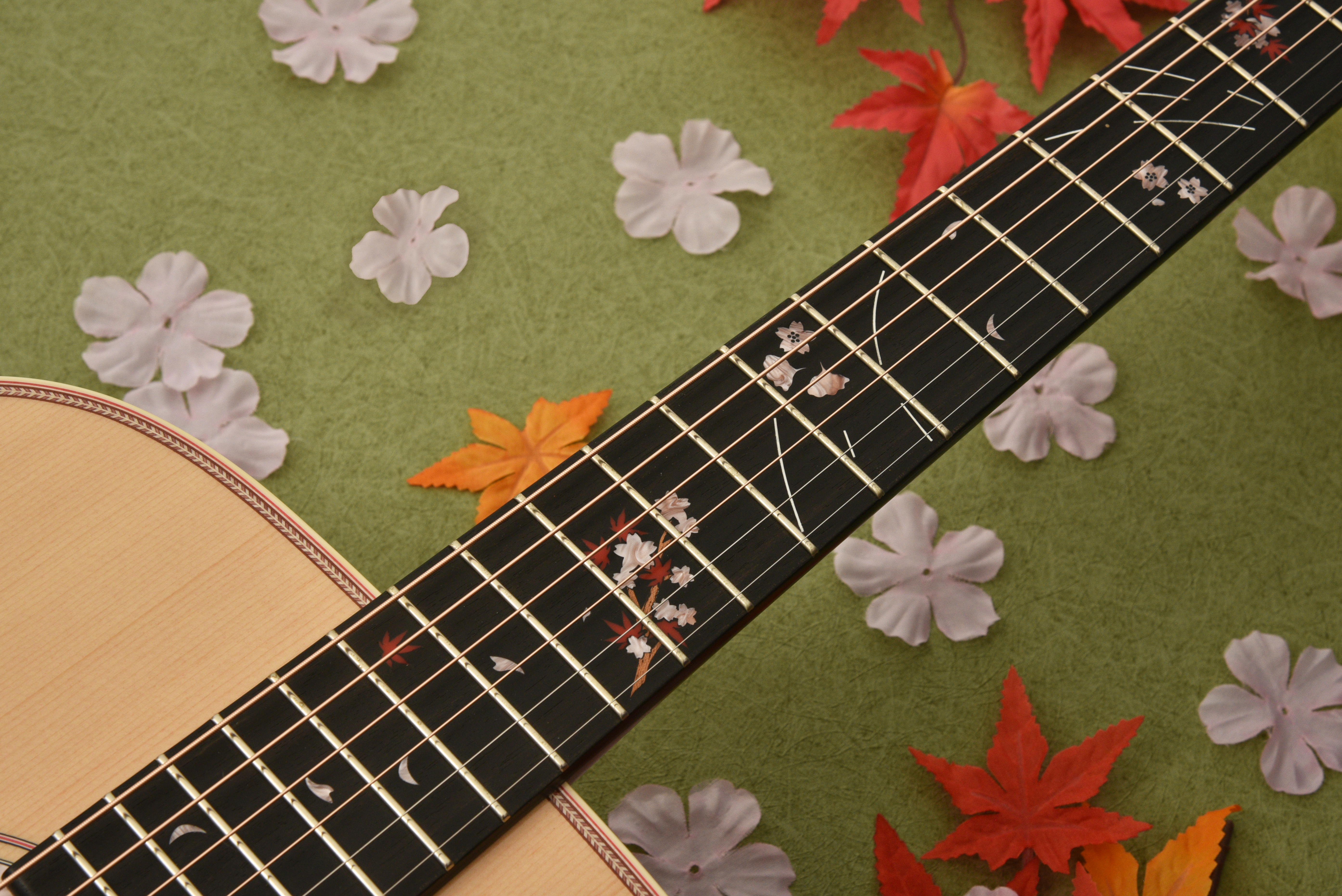
A flowing river design is also included on the jet-black ebony fingerboard. Cherry blossom petals and autumn leaves are placed at the 3rd, 5th, 7th, 9th, and 12th frets, and are flowing with the river from the headstock to the neck end, so that the player can play without losing sight of his position when switching from the regular dot position model.
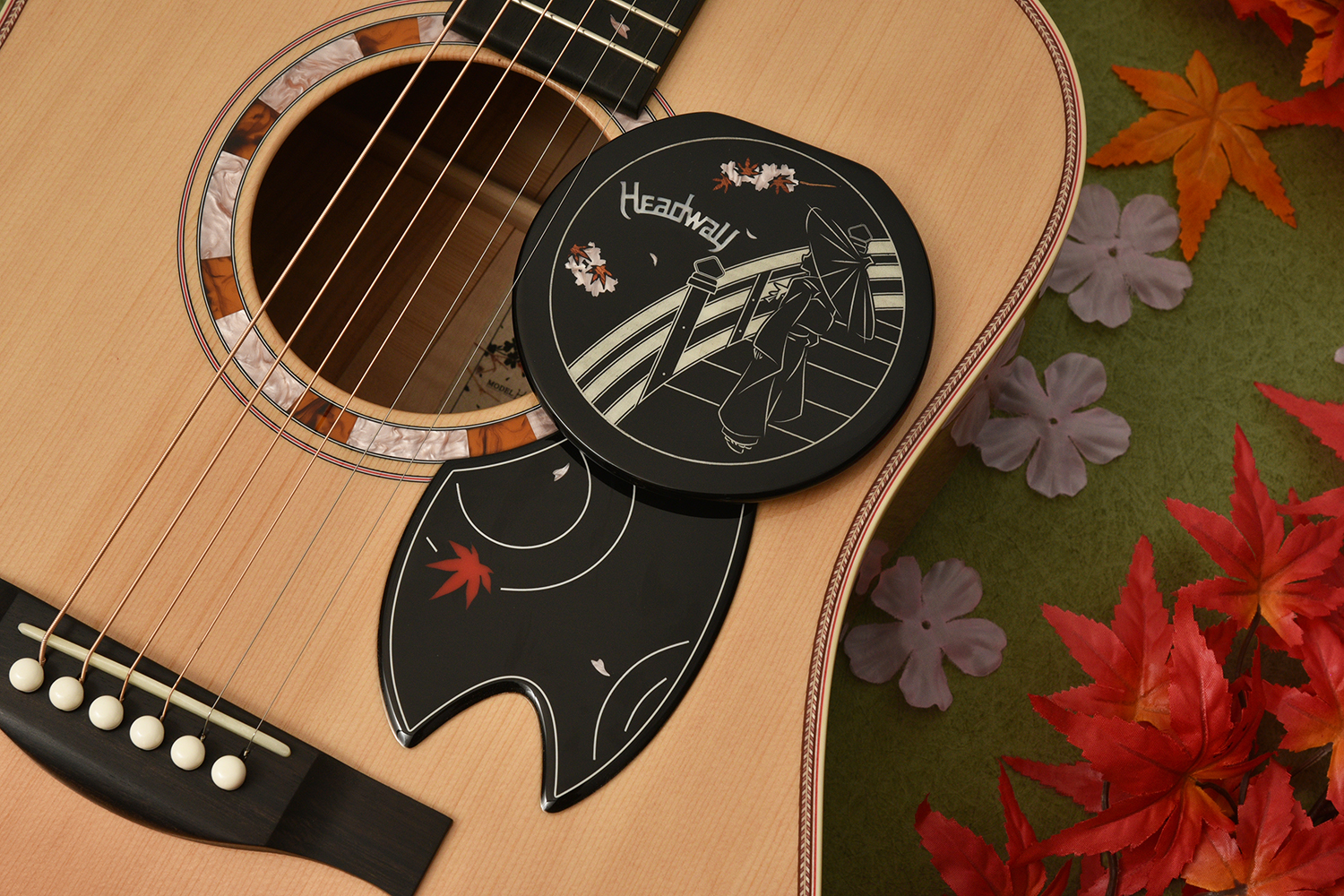
A momentary scene of cherry blossoms and autumn leaves falling on the surface of the water is used in the pickguard design. In addition, two different acrylic materials are used for the rosette around the sound hole to express the coloring produced by the four seasons of cherry blossoms. A sound hole cover is also included, incorporating a design of a woman in kimono, a common theme for the 2022 Sakura model.
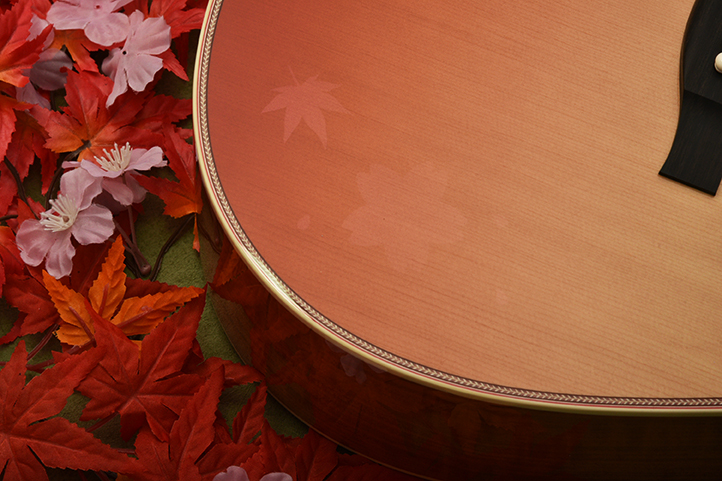
Autumn Red Gradation is a colorful autumnal gradation. The gradation expresses the gradual change in hue folliage experinces during autumn. The lower part of the body is coated with a holographic layer that appears depending on the angle and the reflection of light, bringing out the design of cherry blossoms and autumn leaves.
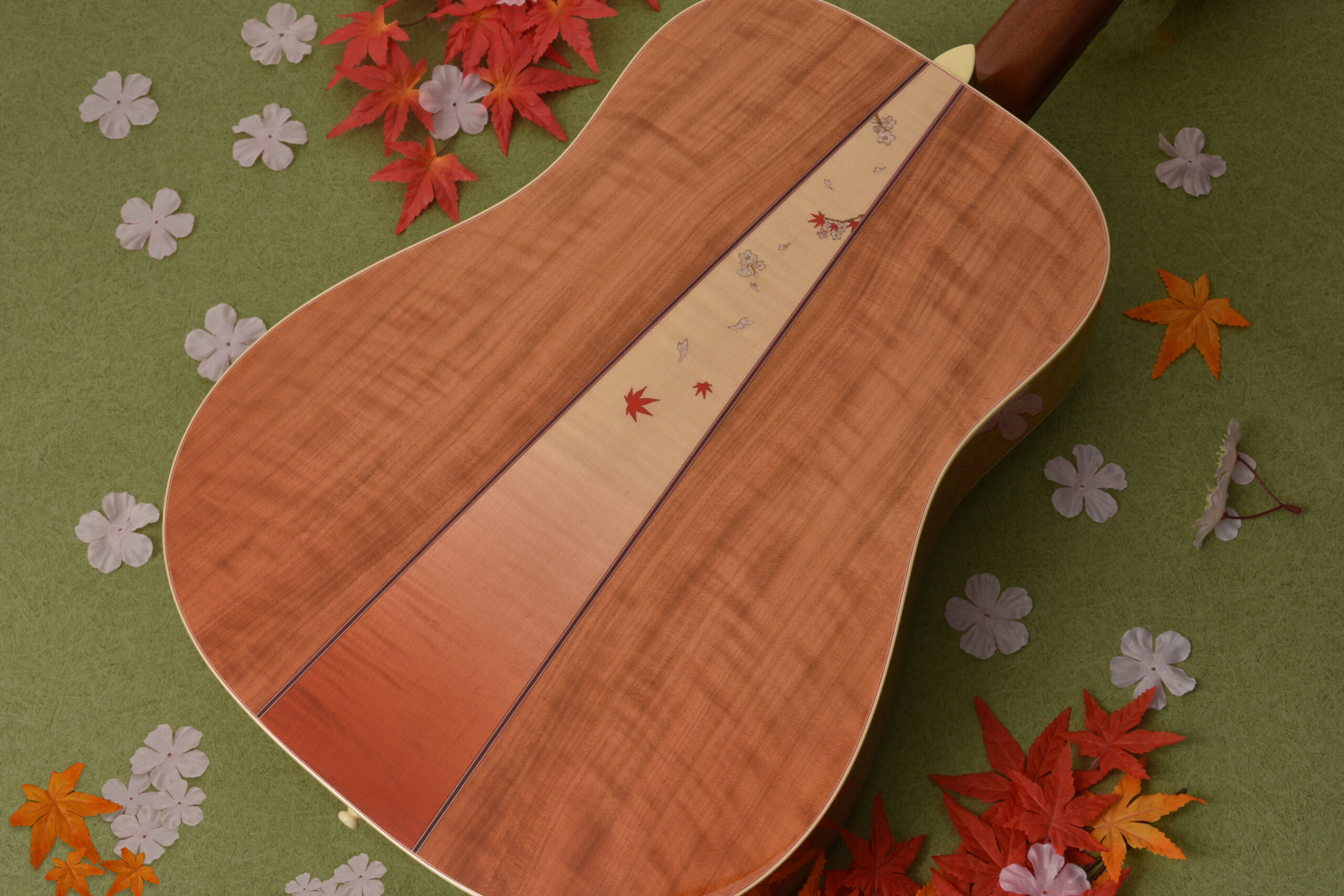
The center of the 3-piece back is made of maple wood with elegant inlays of falling cherry blossoms and autumn leaves. The finish gives a sense of the scenery of Obara even when viewed from behind. Furthermore, by painting the gradation in elegant red color, the leaves that have fluttered down are piled up, giving the image of a landscape where the whole surface is dyed in autumn leaves.


The extra-slim U-neck is the thinnest in Headway’s history and has a shape that is easy to grip. The neck is reinforced with carbon rods to maintain Headway’s traditional characteristics of durability and stability. This is a trustworthy neck grip that women and players with smaller hands should try. The semi-glossy finish, which resembles a neck that has been used and worn in for a while, provides a good grip that allows the hand stick to the neck when just right. In addition, the carbon port increases rigidity and leads to better response.

Headway Master Builder Momose has adopted the “34 bracing” layout, which he has found to give the best on his recent production experience. The layout is closer to a “semi-forward shift” with the X-bracing crossed 4.6mm closer to the bridge side than the forward shift, which is very appealing in terms of strength and stability. The combination of the softness and overtones of the forward-shift bracing and the hard maple wood results in a sound that responds well to even the most delicate and sparkling touch.

Headway uses the traditional dovetail joint method. While in recent years there have been an increasing number of models with simpler bolted joints, the dovetail joint has a larger joint area, and when finished precisely, the neck and body produce a rich sound as if they were a single piece of wood. The joint’s protrusion, called a “dovetail,” is made larger than a standard joint, and a special jig is used to join them together. Adjustment of the neck angle and other parts at this point greatly affects playability and sound, and is a process that requires a high level of skill to pull-off.

The body back is made of Yamazakura, a Japanese wood with distinctive flame-grain patterns. The body is constructed with a 3-piece construction, and kaede (Japanese maple), is used for the center wood. Both materials, yamazakura and kaede, are relatively hard and solid, and the slightly sweet sound characteristic of yamazakura is combined with the crisp and clear sound of kaede, resulting in a sweet and fresh sound that can be produced even by a light touch.


